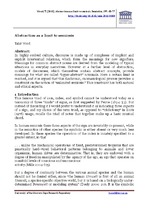| dc.contributor.author | Wood, Tahir | |
| dc.date.accessioned | 2017-09-07T12:37:48Z | |
| dc.date.available | 2017-09-07T12:37:48Z | |
| dc.date.issued | 2013 | |
| dc.identifier.citation | Wood, T. (2013). Abstraction as a limit to semiosis. Semiotica, 197: 65-77 | en_US |
| dc.identifier.issn | 0037-1998 | |
| dc.identifier.uri | http://dx.doi.org/10.1515/sem-2013-0080 | |
| dc.identifier.uri | http://hdl.handle.net/10566/3179 | |
| dc.description.abstract | In highly evolved culture, discourse is made up of complexes of implicit
and explicit inter-textual relations, which form the meanings for new signifiers.
Meanings for common abstract nouns are derived from the modeling of
typical situations in everyday narratives. However at a further level of abstraction,
models of discourses, which themselves contain abstract concepts, provide
meanings for what are called “hyper-abstract” nominals. Here a certain limit is
reached, and it is argued that this diachronic, onomasiological process provides
a constraint on the notion of “unlimited semiosis.” This constraint has both natural
and ethical aspects. | en_US |
| dc.language.iso | en | en_US |
| dc.publisher | De Gruyter | en_US |
| dc.rights | This is the author-version of the article published online at: http://dx.doi.org/10.1515/sem-2013-0080 | |
| dc.subject | Unlimited semiosis | en_US |
| dc.subject | Abstraction | en_US |
| dc.subject | Symbolic | en_US |
| dc.subject | Infinity | en_US |
| dc.subject | Concrete | en_US |
| dc.subject | Discourse | en_US |
| dc.title | Abstraction as a limit to semiosis | en_US |
| dc.type | Article | en_US |
| dc.privacy.showsubmitter | FALSE | |
| dc.status.ispeerreviewed | TRUE | |
| dc.description.accreditation | Web of Science | |

